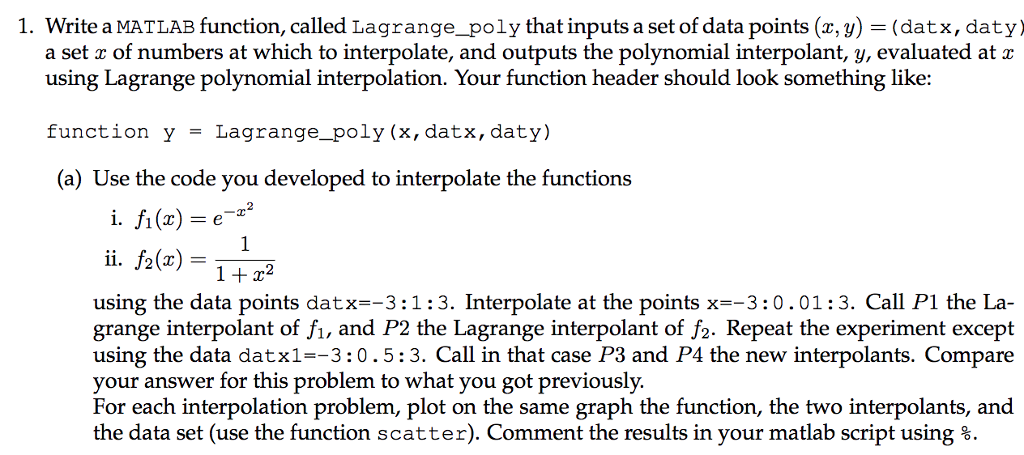Question
My current code: f1=@(x)(exp(-x.^2));%f1 datx=(-3:1:3)';%datapoints daty=f1(datx); x=(-3:.1:3)';%interpolation points P1=Lagrange_poly(x,datx,daty)%Test P1 f2=@(x)(1./(1+x.^2));%f2 daty=f2(datx); P2=Lagrange_poly(x,datx,daty)%Test P2 datx=-3:.5:3;%other data points daty=f1(datx); P3=Lagrange_poly(x,datx,daty)%Test P3 daty=f2(datx); P4=Lagrange_poly(x,datx,daty) %PLOT fplot(f1,[-3,3]); hold
 My current code:
My current code:
f1=@(x)(exp(-x.^2));%f1
datx=(-3:1:3)';%datapoints
daty=f1(datx);
x=(-3:.1:3)';%interpolation points
P1=Lagrange_poly(x,datx,daty)%Test P1
f2=@(x)(1./(1+x.^2));%f2
daty=f2(datx);
P2=Lagrange_poly(x,datx,daty)%Test P2
datx=-3:.5:3;%other data points
daty=f1(datx);
P3=Lagrange_poly(x,datx,daty)%Test P3
daty=f2(datx);
P4=Lagrange_poly(x,datx,daty)
%PLOT
fplot(f1,[-3,3]);
hold on
scatter(datx,f1(datx),'*')
scatter(x,P1,'d')
scatter(x,P3,'filled')
legend('f1(x)','data points','P1','P3')
title('for f1')
figure
fplot(f2,[-3,3],'r');
hold on
scatter(datx,f2(datx),'*')
scatter(x,P2,'d')
scatter(x,P4,'filled')
legend('f2(x)','data points','P2','P4')
title('for f2')
function y=Lagrange_poly(x,datx,daty)
m=length(datx);
ybar=zeros(size(x));
for k=1:numel(x)
result=0;
for i=1:m
term=daty(i);
for j=1:m
if i~=j
term=term*(x(k)-datx(j))/(datx(i)-datx(j));
end
end
result=result+term;
end
ybar(k)=result;
end
y=ybar;
end
Submission feedback:
 Please edit my code to fullfill submission requirements or completely write a new one if wrong. Thanks.
Please edit my code to fullfill submission requirements or completely write a new one if wrong. Thanks.
Step by Step Solution
There are 3 Steps involved in it
Step: 1

Get Instant Access to Expert-Tailored Solutions
See step-by-step solutions with expert insights and AI powered tools for academic success
Step: 2

Step: 3

Ace Your Homework with AI
Get the answers you need in no time with our AI-driven, step-by-step assistance
Get Started


